Un tourism trip to visit Madrid It requires great planning beforehand, because it is such a large city with so much history that you will always leave corners to discover.
No matter how many times you visit it, there will always be secrets and gems to discover, but we are going to show you with this complete guide all the information you need to know to be able to make the most of your time on a trip to the capital of Spain.
Whether or not you first trip to Madrid, in this list you will find access to all the information we have on our blog, which will surely be very useful to you.
It is our hometown and residence, and luckily we know it very well, so we have summarized the experience of many years as briefly as possible to facilitate your trip and show you which are the main monuments and corners that you should not miss.
All the information in detail
2-day route to see Madrid
To give you an idea of the essential places to see in Madrid and the possible route you should take, here is a brief summary of what you will then be able to find in the article placed in order.
Day 1 - Madrid of the Austrias – Historic Center
- Plaza de Oriente, Royal Palace, Almudena Cathedral, Plaza de la Paja, Plaza de la Villa, Mercado de San Miguel, San Ginés, Plaza Mayor and Barrio de Las Letras
Day 2 - From Retiro Park to the Temple of Debod
- Retiro Park, Puerta de Alcalá, Plaza de Cibeles, Prado Museum, Carrillón, Congress of Deputies, Gran Vía, Plaza de España, Temple of Debod and Malasaña or Chueca
Map of the Route through Madrid in 2 days
To make it easier for you to follow the route that I have prepared for you, we have left you the map with the places to see in Madrid in 2 days. This way you can carry it on your cell phone to explore the city.
To get to the departure point of each place, I recommend that you use the metro to get to the closest stations.
As you can see on the map, this route is designed to be able to explore everything on foot.
Day 1 – What to see in Madrid de Los Austrias, the historic center
If you are interested and before starting the route, we leave you several articles that can help you on your trip.
- Guide for traveling to Madrid (TIPS)
- 5th essential places to see in Madrid
- Route through Madrid of 3 or more days
Now yes, let's go with the route through Madrid.
El historical origin of the city It is the fortress that the Arabs built in the 9th century on the site now occupied by the Royal Palace.
And the Madrid of the Austrias It is the development carried out between the 16th and 18th centuries by the kings of the Habsburg dynastyat Carlos I a Charles II, going through the Philips II, III and IV.
The entire historic center was built by the different kings who shaped the city and many of its streets are the same today.
Plaza de Oriente
We are going to start our route from an icon of Madrid, the Plaza de Oriente one of the main axes of Madrid de los Austrias
The Plaza de Oriente It opened at the beginning of the 19th century with Joseph Bonaparte and it's not just a square in Madrid.
In this seemingly small area there are several very interesting places to visit.
It is a corner where you can see the statues of the Spanish kings and equestrian statue of Philip IV, in addition to being an area with a lot of atmosphere at all hours every day of the year.
On the other side of the square is the Royal Theatre which was inaugurated in the reign of Elizabeth II and was built in the mid-19th century on top of another older one, the Caños del Peral Comedy Corral.
ORGANIZE your TRIP
- Don't forget your TRAVEL INSURANCE with a 5% discount
- Book the HOTEL for your trip
- RENT a CAR for your trip
- The best TOURS and EXCURSIONS in Spanish
- NO-LINE TICKETS for museums and monuments
- Best FREE TOURS around the world
- Book your TRANSFER from the airport
- eSIM card with INTERNET at the best price
From that square you can see the Sabatini gardens, but if you want to see a brutal garden, behind the Royal Palace are the Moro Gardens. It is true that it requires a little time but it is worth it.
Madrid's Royal Palace
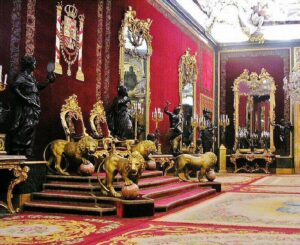
Right in front of the Plaza de Oriente is the Royal Palace, one of the most visited moments in Madrid and stands in the same place where the old Alcázar of Madrid.
The castle that occupied its place was a Muslim castle from the 1734th century that, after being renovated to become a royal residence, burned down in XNUMX.
Philip V He ordered the construction of a new palace, whose works would take place over several decades and several reigns.
Also known as the East Palace, the Royal Palace is not currently the residence of the King despite appearing as his official residence.
It stopped being used by the monarchy with the arrival of the first republic, whose Prime Minister Azaña He was the last one to reside there.
As it continues to be used for official ceremonies, it is a palace that remains alive and whose visit is a must in Madrid.
Here is the changing of the guard and in addition to being able to visit its interior with the official lounges, the armory and Sabatini Gardens.
Here we leave you all the information you need to visit it, with schedules, ticket prices and how to avoid lines.
Almudena Cathedral in Madrid
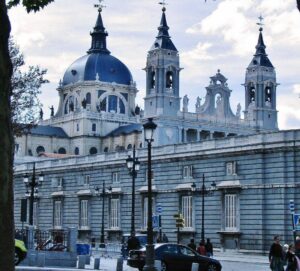
La Cathedral of La Almudena It is the religious building par excellence in Madrid.
It is where the statue of the Patroness of Madrid, the Virgin of Almudena, and it is a true mix of architectural styles.
It has a neo-romanesque crypt, impressive stained glass windows, but its strong points are its main interior nave and the dome.
Walking towards the main altar you are amazed by its impressiveness. gothic ship full of paintings on its ceiling and packed with objects and ecclesiastical relics.
However, beyond the amazing interior, our favorite area is the viewpoint of the summit, which you can climb to discover one of the most beautiful images of Madrid.
The viewpoint is the final touch to the visit to the cathedral, from where you can see the Royal Palace from the heights and House, without a doubt one of our favorite places in Madrid
Here we leave you practical topics that can help you visit it.
Straw Square
Taking Bailen Street and crossing the viaduct of the Segovia Bridge you reach Plaza de la Paja.
During the Middle Ages It was the main square of Madrid and one of the most populated suburbs.
Its name comes from the straw that was sold in the market, which was intended to feed the mules that were used to transport goods or in the fields to plow.
Don't forget your Travel Insurance
Are you organizing your trip or getaway? Don't leave without take out your travel insurance before, and here we explain why. If you hire it with us, you have a 5% discount
La Bishop's Chapel and Gardens of the Prince of Anglona They are the most relevant places of what today is a quiet square where traditional celebrations are held. Pigeon Festival.
Plaza de la Villa in Madrid
Very close is the Plaza de la Villa, where until recently the house of the village, headquarters building Madrid City Council.
It is a building with an architecture very similar to the impressive Monastery of El Escorial on the outskirts of Madrid, which as a curiosity was also used as a prison.
In this square there is also the oldest house or building preserved in Madrid, the House of Los Lujanes from the beginning of the 15th century, a medieval building with Mudejar features where the Arab influence can be seen in the arches of the tower.
San Miguel Market
Following the route and before reaching Plaza Mayo we recommend a little stop.
In the place where historically there was a traditional market, today we find one of those modern markets in the style of the Boquería market in Barcelona.
A lot of stalls where you can have pinchos and tapas, which to be honest is focused on getting money from tourists. Although we do not recommend an entire meal in the market, it is a good place to have a beer or a soft drink with a skewer before continuing the route.
Because regardless of the prices of the premises, the building is very nice and it is not a bad place to sit for a bit.
It is worth visiting if only to see the beautiful industrial style structure. Furthermore, on this route it is completely in passing.
Plaza Mayor
and as soon as we left the market we arrived at the Plaza Mayor.
In medieval times, the Plaza Mayor of Madrid was the suburban square, a large irregular space outside the walls that surrounded the city, dedicated to trading all types of products.
With the urban transformation of Madrid, was the king Philip II the one who would order the construction of a new plaza that would reflect the power of an imperial capital such as Spain was at that time, but Philip III He is the one who gave the definitive impetus to the project.
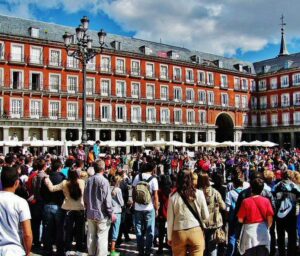
A square full of ornamentations and mural paintings where they have been developed for many years traditional crafts.
From there come the names of the doors that give access to the square.
As a curiosity, in 1790 after a big fire The buildings in the square were almost completely destroyed, and they were rebuilt based on the Bakery House, which was one of the few buildings that survived the fire.
Book your hotel, 15% discount, free cancellation
When planning your trip, we advise you to, well in advance, Book your hotel now on booking.com where you can find discounts from 15% and you will have a possible cancellation for free
It is a square that currently has many uses, such as Christmas market that every year fill its stone floors with color.
San Gines Chocolate Shop
The next stop takes us very close to the Plaza Mayor.
And if you had not stopped to have a skewer before because you wanted to eat something sweet, this is your place.
The San Ginés chocolate shop is one of the most emblematic traditional places in the capital and the typical place to have a chocolate with churros that is something very traditional.
It is very rare to find a Madrid native who has not visited, especially on New Year's Eve.
We leave you an article so you can see it well.
Puerta del Sol and surroundings
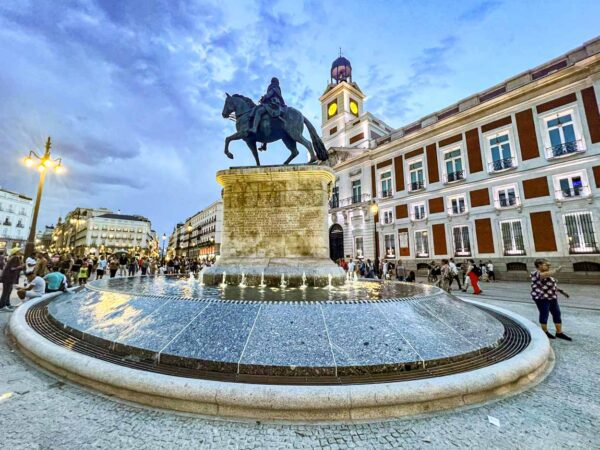
And after a chocolate and churros, we return to the route to the central point of Madrid.
La Puerta del Sol It is one of the most emblematic points not only of Madrid, but of Spain, since the Kilometer 0 of all the radial roads that structure the network of state highways that go to the ends of the country.
La Puerta del Sol It is a square full of representative icons of the city, such as the Statue of the Bear and the Madroño which is found in the city's shield, the equestrian statue of Charles III or the mythical Uncle Pepe poster, a historical label that has appeared in numerous films.
It is the authentic heart of the city, and in front of its main building the change of year is celebrated with the traditional 12 grapes, which must be taken at the rhythm of each of the 12 bells, in addition to being the square where the people gather. people in many of the demonstrations that take place in the capital.
Reserve your RENTAL CAR now for your trip
Looking ahead to your trip, book your rental car now on this website that offers you the best price guaranteed and allows you a possible free cancellation in most cases. Here you have more information with tips for renting a car
Although originally it was Post House, today this building is where the headquarters of the Region of Madrid.
Here I leave you interesting articles about Puerta del Sol so you know what to look for during your visit.
Barrio de las Letras and Plaza Santa Ana
On the first day's route, what we recommend is not to load the program and leave the afternoon and evening to wander around Madrid and experience the atmosphere of the city.
And that is why our recommendation, once you have visited Puerta del Sol, is to head towards the neighborhood of letters and the area around Plaza Santa Ana, which are next door.
It is an area full of classic Madrid bars and restaurants with Huertas Street as the main axis, where you can experience the rhythm of the capital doing the official sport of Madrid, terrace riding.
A perfect end to the first day in Madrid.
By the way, if you are interested, in this area there is the Reina Sofía museum where you can see Gernika.
Day 2 – From Retiro Park to the Temple of Debod
Whenever someone tells us that they have only two days to visit Madrid, we ask them the same thing, the first day the Madrid of the Austrias and the second is the one we are going to show you now.
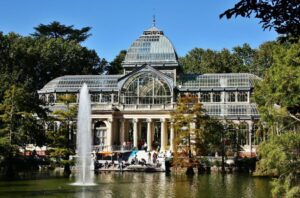
These visits are placed in order in such a way that you start the day enjoying the morning in the Retiro Park and you go through each of the places that we are going to show you, to end up seeing what for us is the best sunset. from Madrid.
Parque del Retiro
El Parque del Retiro is Madrid Central Park, the urban lung of the city and one of the most visited places by Madrid residents themselves.
A huge oasis of peace where you can read and do sports in nature in the center of the city.
It is a space full of gardens, monuments, and enormous trees where all of us from Madrid take refuge from the high summer temperatures.
This is where the traditional Book Fair in spring, in addition to having several very interesting points, since it is not only a park, but an open-air museum.
El Crystal Palace, monument to Alfonso XIII next to the well-known Pond of the Retreat where you can row in the boats that ply it, the numerous sources, the Rose Garden or the neo-byzantine church that are next to the park, are corners that you cannot miss.
Puerta de Alcalá
Leaving the Parque del Retiro towards the city center along the Puerta Real, we find one of the most photographed monuments in Madrid, the Puerta de Alcalá.
Located in the Plaza of Independence, Together with the Serrano Street, one of the most expensive in the country, is one of the five majestic gates that gave access to the city of Madrid to all travelers who came years ago from France.
Although this is not its original location, as the famous Spanish song says “there he is watching the time go by" since 1778.
It is the beginning of the Alcalá Street which takes us into the Gran Vía, Madrid Broadway and a street full of life.
Plaza Cibeles and surroundings
But before entering Gran Vía, you pass through the mythical Plaza de Cibeles.
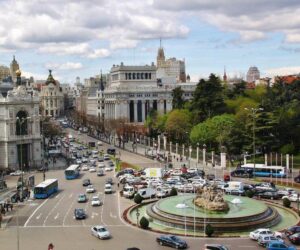
La Cibeles Square It is perhaps the Madrid square that houses the most important elements in its surroundings.
This square is one of the backbone of the city, since two emblematic streets intersect, the aforementioned Alcalá street and Castellana street.
In the center is where the statue of the goddess Cybele, on the sides the Linac Palace and Palace of Cibeles, the current headquarters of Madrid City Council and old Post Office House.
The sculpture of the goddess Cybele is famous worldwide because it is where Real Madrid celebrates its titles by wrapping a scarf around its neck.
On one side, the Palace of CibelesIn our opinion, one of the most beautiful buildings in Madrid.
It is essential to go up to its terrace where there is a great viewpoint from where you can see the Plaza de Cibeles from above and the path that leads to Gran Vía.
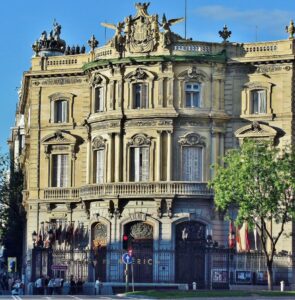
And it is no coincidence that together with Palace of Cibeles another palace is found, this time the Linac Palace, in which the House of America.
And it is that in the Paseo de la Castellana There were many old palaces that were destroyed over the years, but the Linac Palace he managed to stay upright.
It is a true architectural gem that was completed at the end of the 19th century and has a style similar to that of the Royal Palace And, as a curiosity, it is full of legends, since there is a rumor that a ghost walks through its rooms.
Meadow Museum
He is known as Triangle of Art It houses three top museums worldwide, the jewel in the crown being the Prado Museum, but also including the Thyssen-Bornemisza and the Reina Sofía.
But among them, without a doubt, the one that stands out above the rest, and to which thousands of tourists come from all over the world just to see it, is the Prado Museum.
From Plaza de Cibeles and going down Paseo de Prado you reach Plaza de Neptuno.
And this is where the Museo del Prado, and this is the time to visit it, because you cannot leave Madrid without taking at least a walk through its main rooms.
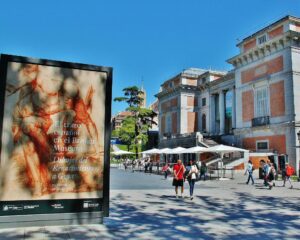
A visit can take as long as you want, from a minimum of 1-2 hours just seeing what is important, to as long as you want, if you are passionate about painting.
Keep in mind that The Prado Museum is considered the largest art gallery in the world.
A unique museum that houses 7.600 works, including some of the most important ever painted by the most important painters in history, such as Diego de Velázquez, Picasso, Francisco de Goya, Hieronymus Bosch, El Greco, Titian, Murillo, Rubens, Rembrandt or Sorolla among others.
Here are works such as Las Meninas, The Majas o The Garden of Delights, all with incalculable value.
Whether you are a lover of painting or not, this museum brings together hundreds of chapters of world history.
It is a museum that always has waiting lines, so here we leave you articles that can help you with practical information on how to visit it.
- How to visit the Prado Museum for free
- Schedules and ticket prices for the visit to the Thyssen Bornemisza museum
- Hours and ticket prices for the Reina Sofía Art Center Museum
Neptune, Carrillón and Congress of Deputies
Being an area with so much heritage value, just by walking through it Paseo del Prado and the environment of Meadow Museum You can see some beautiful places.
Write down those that, although we do not include them in this route, can help you if you have more days to visit Madrid.
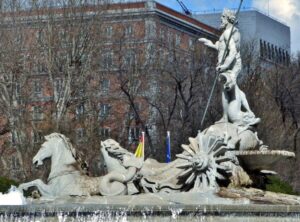
The National Archaeological Museum, Jerónimos Church, the station Atocha, which apart from being a railway station, is a very peculiar place, since inside it has a greenhouse garden with its own pond full of turtles and outside there are interesting buildings such as the old Ministry of Public Works.
But returning to Plaza de Neptuno, this is where some of the most historic hotels in the capital are located, such as the ritz or the Palace, the latter right in front of the seat of Spain's sovereignty, the Congress of Deputies, what's the next stop.
After climbing towards the San Jerónimo Race To get to Congress, in front you have to stop at the curious corner of the Plus Ultra Chime which is on the same street.
The times at which the chime is activated are 12, 15, 18, or 20 p.m., so you can see it working if you pass by at those times.
Next you must continue uploading the San Jerónimo Race and cross the Canillejas square with its beautiful buildings to reach the Puerta del Sol.
Circle of Fine Arts and Metópolis building
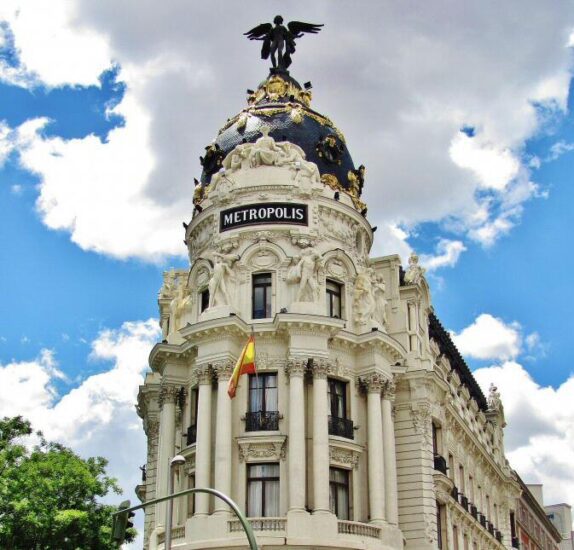
After visiting the Congress, the route takes us to the Gran Via of Madrid, but before entering we are going to go up to a viewpoint.
And we are referring to the roof of the Circle of Fine Arts from where you can see the Metropolis Building which is the gateway to Gran Vía from Cibeles
This visit is highly recommended and we have an article in which we inform you how to go up.
Gran Vía
Now we enter one of the most important streets in the country, where all the major brand stores, theaters and cinemas, with their musicals, as well as buildings full of history are located.
The Gran Vía is the essence of life in Madrid, a street through which thousands of people pass every day, being the third busiest street in Europe.
It is a main artery of the city where the ideal is to walk looking up, since each and every one of the buildings that make it up are truly spectacular.
To highlight, at the confluence with the Alcala Street, metropolis building, one of the best architectural examples in Madrid.
Also that of the current Madrid Casino which was in its day the Commercial Union Circle, the Telefónica Building, in its day, one of the tallest in the capital, or the old Gran Vía hotel where Hemingway wrote his chronicles of the Civil War.
Interesting topics on Gran Vía:
Plaza de Callao
In the central part of Gran Vía is the Callao square which gives access to the entire commercial area and squares such as Puerta del Sol, through streets that are filled with color every year with Christmas lights, such as Preciados or the Carmen Street.
It is one of the liveliest areas of the capital, with historic buildings of old cinemas and where you can literally find people walking at any time of the day or night at any time of the year.
Plaza of Spain
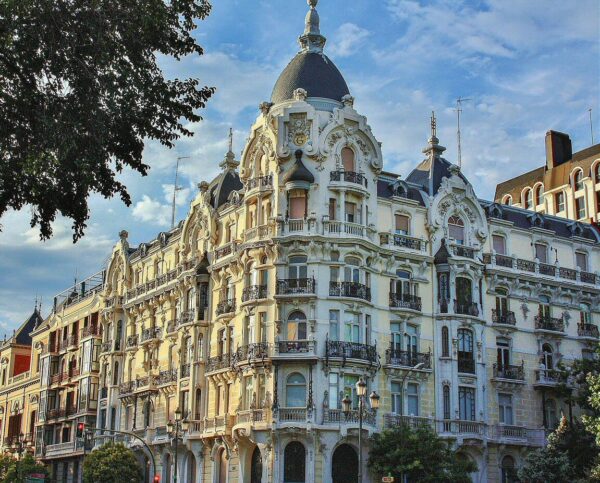
Continuing from Callao along the Gran Vía, you will reach the Plaza of Spain where what was once the tallest skyscraper in the city is located.
It is a spacious and peaceful space in the heart of Madrid, which has recently been rehabilitated, where the monument to Miguel de Cervantes , the two large skyscrapers that design its image, and the Gallardo House, an example of modernist architecture in the capital.
There you have the opportunity to go up to one of the currently most popular viewpoints in Madrid, the Hotel Riu Plaza de España.
- What to see in the new Plaza de España
- How to go up to the terrace of the Riu hotel
- This is Casa Gallardo, a modernist building in the Plaza de España
Temple of Debod
For those of you who like sunsets, this place will leave you shocked; Every day many people arrive with their tripods to photograph the sunset in this unique park in the capital.
El Debod Tempo It is made up of small buildings that are actually Egyptian funerary monuments.
It was donated in its day by the Government of Egypt for the help that Spain provided so that the African country could preserve archaeological remains of Abu Simbel.
From this beautiful park you can also see one of the most beautiful panoramic views of the city, with the Royal Palace dominating the panorama, leaving at your feet the Manzanares river that crosses the city, and right in front, the House
If you are looking for a sunset, this corner of Madrid is pure magic, and if you have a clear day but with some clouds in the Sierra area, prioritize this visit because your hair will stand on end with the colors seen in this sunset .
Malasaña and Chueca
To end the day, you take the metro or walk as you wish, to two other neighborhoods in Madrid, Malasaña with the Bilbao and 2 de Mayo squares and the Chueca neighborhood with its square as its epicenter.
Two places to continue enjoying the terrace and the atmosphere of Madrid
Tours and excursions in the surroundings of Madrid


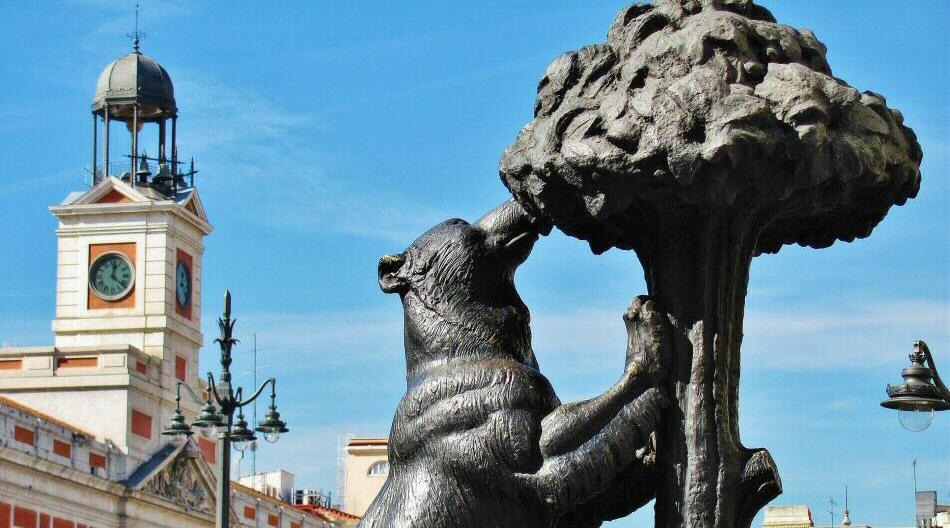

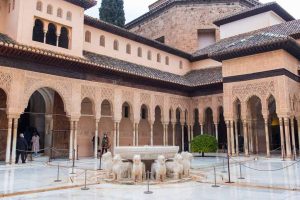
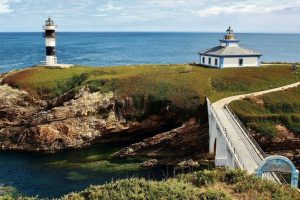











I'm going this weekend 5/2/2016 I'll tell you how it goes, for now I'm looking forward to greetings
Good morning. What I have available is mid-afternoon and they suggest me at the Toledo agency
But I have Madrid at night...
What do you recommend costeffective?
show_ I like music
It's the first time I've entered Madrid.
Thank you..it is that then you have Barcelona excursion
Vilma, to visit Toledo you need a whole day, half a day is not enough.
Good morning. What I have available is mid-afternoon and they suggest me at the Toledo agency
But I have Madrid at night...
What do you recommend cost-effective?
show_ I like music
It's the first time I've entered Madrid.
Thank you ..
Very good tour for 2 days. Yes sir!
Hey.
Tell me one thing: this route is easy to do on foot, or you have to do it by car.
Thank you
Francisco, this route is not to be done by car (also it is not possible by car). It is a long walk that can be complemented with the help of the Metro if you need to move faster, cut it short, or rest a little :)